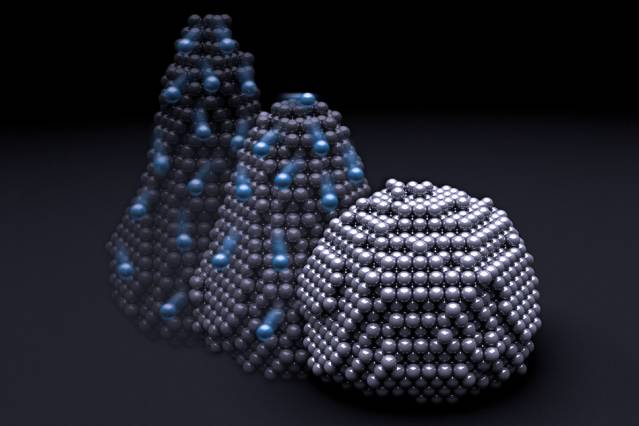 Image: Yan Liang
Image: Yan Liang
A research team from MIT has discovered a new phenomenon in metal nanoparticles in which they resemble liquid droplets and appear wobbling from the outside whilst maintaining a stable configuration on the inside.
The team carried out the experiment using pure silver particles of less than 10 nanometre across (one-thousandth of human hair width) at ambient conditions. Hints of a similar phenomenon had been observed whilst studying tin but due to its low melting point the effect was less obvious. As a result of the relatively high melting point of silver, such behaviour was more easily observed in silver nanoparticles.
Whilst metal nanoparticles are used in a wide range of research applications from electronics to pharmaceuticals, deformations remain a major limiting factor in nanoparticle applications. The deformation of silver or gold nanoligaments in electronics applications for instance could result in failure of electrical connections.
The researchers used atomistic modelling and a transmission electron microscope in order to obtain a detailed image of the nanoparticles, which revealed the movement of only the outer layer of one or two atoms at a given time.
Due to the movement of outer atomic layer across the surface and its ability to redeposit, the nanoparticles appear to move with a greater impact. However, the molecules inside the particles stay intact due to their crystalline nature. The arrangement of the crystal structure could be disturbed when the droplets melt to a liquid state.
Scientifically, the phenomenon of particle deformation is pseudoelastic in nature – the material gains its original shape when the stresses are eliminated. The researchers observed the principle of Coble pseudoelasticity in metal nanoparticles.
The liquid-like nature of nanoparticles can be removed by covering the particles with a thin oxide layer, making them suitable for use in stable electrical circuits. By contrast, this phenomenon could be applied in electrical contacts that remain unchanged to rotational reconfiguration. In this case, oxide layer of the particles can be destabilised using noble metals or at a reduced atmosphere.
The mechanical strength of the particles increases with the reduction in particle size. This behaviour can be observed with particles of 10 nanometre size at room temperature. Under this threshold, a precipitous drop is formed depending on the strength of the nanoparticle.
The findings, published in Nature Materials journal, can also be used to explain discrepancies involved in other nanoparticle related research.